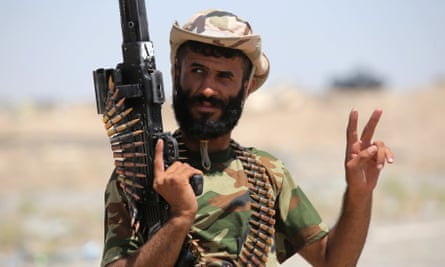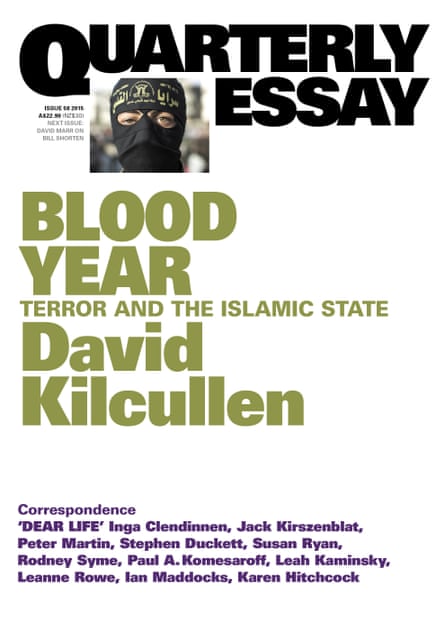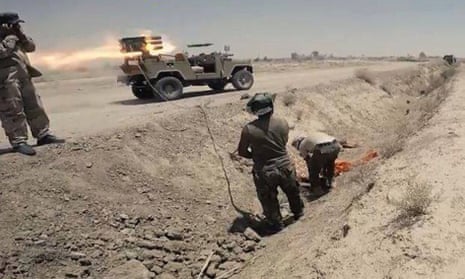We’re living in an era of persistent conflict. This isn’t my insight – you can read it in the latest concept documents of half a dozen western militaries. But it doesn’t seem to have hit home, for the public or some policymakers, that the notion that this can all end, that we can get back to some pre-9/ 11 “normal,” is a fantasy. This – this instability, this regional conflict surrounded by networked global violence, this convergence of war and crime, of domestic and international threats, this rise of a new aggressive totalitarian state from the rubble of the last war – is the new normal, and it’s not going to change for a very, very long time. There are no quick solutions: we need to settle in for the long haul.
That being the case, we have to figure out methods of dealing with persistent conflict. As I’ve said in my Quarterly Essay, Blood Year, I see no alternative to a larger, more intense, conventional war against Isis than the one currently being contemplated (though emphatically not an occupation or a counterinsurgency campaign).
Isis is an escalating threat that’s growing and worsening. The longer it takes to deal with [it], the further its influence spreads, the more recruits it attracts, the harder it is to dislodge from the cities it has captured, the more deeply it’s able to harm the communities it controls, the more civilians will ultimately be killed, and the greater the military response ultimately required to defeat it. This is a case when the job will become much harder, require much more lethal force and do more harm as time goes on: we have to go hard, now, or we’ll end up having to go in much harder, and potentially on a much larger scale, later – or accept defeat. The risk is not that Isis will somehow restart its blitzkrieg and conquer Iraq and Syria. Rather, the threat is that of a regional conflagration if there’s no effective international (which, like it or not, means western-led) response.
What would such a response look like?
The first issue is that the air campaign has been far too limited. Containing Isis is one thing; destroying its ability to function as a state is quite another. For comparison, during the 78-day intervention in Kosovo in 1999, Nato flew 19,484 airstrike sorties, an average of 250 per day. During the 2011 air campaign in Libya there were 9,700 strike sorties over 215 days, or 45 per day. US aircraft flew 6,500 strike sorties into Afghanistan in just the period from 7 October to 17 December 2001, roughly 83 strike sorties per day.
By contrast, in the nine months of the air campaign until 31 March 2015, US Central Command reported only 2,796 strike sorties, slightly more than 10 per day, across both Iraq and Syria. Strike rates are not the only (or even the most important) metric here – what’s more important are the types of targets being struck, which are often low-level, tactical military assets like artillery pieces or fighting positions. We haven’t seen the sort of strategic air offensive that would be needed to take apart Isis as a state-like entity (as distinct from merely damaging its military capabilities).

The risk is that we might be putting enough pressure on Isis to make it adapt – its forces move by night now, in smaller groups, in civilian clothes, hide in cities, and its command-and-control systems are more decentralised – but not enough to destroy it. One of the key reasons for the limited number of airstrikes is the lack of trained forward observers and controllers on the ground – which is related to the next problem.
This is that ground troops – from the United States, Australia, Canada, the UK and Germany, as well as several regional powers – are constrained by far too restrictive rules of engagement. Most (though not all) of these troops are confined to training bases, where their role is to advise and assist Iraqi and Kurdish forces, offer equipment and intelligence, and engage Isis only in immediate self-defence. This won’t suffice when battles for major cities like Mosul take place: advisers will have to be able to accompany their supported units into battle, not just wave goodbye as they leave the base. Specialists like Joint Terminal Attack Controllers will be needed to move with the forward troops to coordinate airstrikes and artillery, and if necessary – and it’s a near-certainty that it will be necessary – western troops will need the authority to fight offensively, not just in self-defence. They’ll also need to reach out to tribal and irregular units – old allies from the Awakening – who’ve been off-limits to date.
Third, these limits have strengthened the role of Iran in the conflict. Iranian aircraft have flown sorties against Isis, and Qasem Suleimani (who, remember, is head of the Quds Force, which sponsored Shi’a death squads in Iraq in 2005–11) now operates openly on the frontlines of the campaign, with hundreds of Iranian advisers, subject to few of the restrictions on western troops. Many of those former death squads are now operating as militia in Sunni-majority areas. Iran offers weaponry, ammunition and funding, and (with Lebanese Hezbollah) sponsors approximately 100,000 Shi’a paramilitaries, known as Popular Mobilisation Forces. This confirms to Sunnis that the forces opposed to Isis are controlled by Iran.
More broadly, Iran is cementing control over a huge tract of territory that stretches all the way from the western frontier of Afghanistan to the Golan Heights on the Israeli border, which – along with its nuclear program, sponsorship of Palestinian terrorist groups and support for Yemen’s Houthis – is a key provocation driving Israel, Turkey and the Sunni Arab states towards a region-wide, and potentially nuclear, hot war with Tehran.
Greater western involvement would mitigate all these problems, since regional countries (Iraq included) much prefer US assistance against Isis, and are accepting Iranian help mainly for lack of other options. It would also make efforts to curb mounting Sunni–Shi’a conflict far more credible if western countries offered Sunni states a better alternative than war with Iran or simply accepting Shi’a Persian regional dominance. This would also require international action against the Assad regime – or, at the very least, much greater engagement in forcing a negotiated settlement of the conflict in Syria.

At present in Iraq, the United States is in a de facto alliance with Iran against Isis. Both countries deny they’re cooperating, claiming they simply act in parallel, but since both coordinate with the Iraqi government there’s actually a close alignment. This was clearest in March and April 2015 near Tikrit, where Iraqi troops (including Popular Mobilisation Forces) stalled in heavy urban fighting, taking the city only after airstrikes from the US coalition. The fact that Iranian-sponsored militias boycotted the final phase of the Tikrit offensive in protest against US involvement underlines the difficulty of this partnership.
On the other side of the frontier, US passivity and reluctance to target Assad (though his regime kills more people than Isis) makes many Syrians wary of joining the “moderate” rebels. Many loathe Isis, but they have no reason to go against it if that will only help the regime – as it’s currently doing. As coalition airstrikes target Isis, Assad’s forces have repeatedly stepped into the gap and expanded the area under his control.
In this sense, Syria 2015 is like Pakistan 2002 – it’s the complex, intractable problem western leaders don’t want to address. In 2002, after the invasion of Afghanistan failed to eliminate Osama bin Laden, President Bush switched his attention to Saddam Hussein. But Saddam was a distraction from the real problem: figuring out how to deal with AQ and the Taliban once they were established in Pakistan.
Likewise, in 2015, President Obama and other western leaders have focused on Iraq – a difficult problem to solve, though relatively easy to get our heads around. But unless we resolve the conflict in Syria, nothing we do in Iraq will work. Just as AQ and the Taliban destabilised Afghanistan from their cross-border safe haven in Pakistan after 2002, the Islamic State can always use its sanctuary in Syria to recover from defeat in Iraq. And this sanctuary will remain open to it until Syria’s civil war comes to an end.
Hence, a critical counterpart to the “war strategy” to neutralise Isis in Iraq is a “peace strategy” in Syria – to end the slaughter by convincing all players that they can’t achieve their goals through continued conflict, that their best alternative is a negotiated peace. As in Bosnia, Kosovo and Libya, there may be a role here for the military (specifically, air power): creating humanitarian corridors and no-fly zones, or inflicting sufficient damage on armed actors to force a ceasefire. But ultimately this is a political problem – and it will demand at least as much strategic effort and attention as the military problem in Iraq.
This is an edited extract of David Kilcullen’s Quarterly Essay 58, Blood Year: Terror and the Islamic State, quarterlyessay.com
